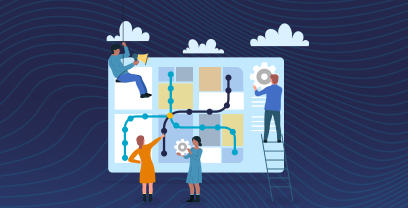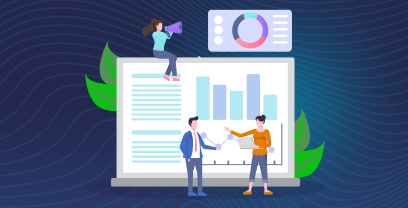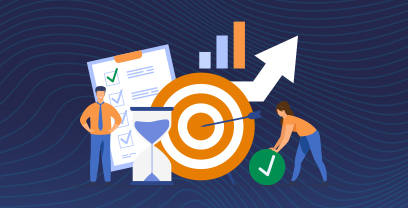Procurement and supply chain management are often used interchangeably—but in practice, the lines between them can blur in ways that create real friction.
Misaligned priorities, siloed systems, and unclear ownership can directly impact key performance indicators like cost savings percentage and procurement cycle time.
At Ivalua, we’ve worked with hundreds of global enterprises to bridge these gaps, streamline operations, and build stronger, more connected processes.
In this blog, we cover the key differences between procurement and supply chain management, and explain where the biggest disconnects typically occur. Additionally, we’ll propose a best-practice framework for making collaboration more effective.
Key Takeaways
- Procurement and supply chain management serve different functions, but when misaligned, they create costly inefficiencies and delays.
- Lack of shared data, visibility, and KPIs leads to disconnects, including poor supplier performance tracking and missed savings.
- Integrated platforms unify procurement and supply chain teams, improving collaboration, compliance, and supplier relationship management.
- Best-in-class enterprises use AI and automation to bridge gaps, enhance visibility, and build more agile, resilient operations.
Discover how Ivalua’s Supply Chain Collaboration solution empowers you to work more closely with suppliers, reduce risk, and build a more agile, connected supply chain.
Procurement vs. Supply Chain Management: What’s the Difference?
At a high level, procurement focuses on sourcing the goods and services an organization needs, while supply chain management oversees the broader flow of those goods, from raw materials to end customers.
But within an enterprise, being aware of the differences between the two functions will shape strategy and operations, and ultimately impact performance.
Here are some key distinctions to make between Procurement vs. Supply Chain Management:
- Procurement is responsible for identifying suppliers, negotiating contracts, and ensuring cost-effective, compliant purchases. It’s heavily tied to spend management, risk mitigation, and supplier performance. In many organizations, procurement also plays a critical role in ESG compliance, innovation sourcing, and maintaining business continuity during supply disruptions.
- Supply Chain Management (SCM) involves orchestrating a product’s or service’s entire lifecycle, from sourcing and production to delivery. SCM is focused on efficiency, throughput, and resilience across a much wider operational footprint and requires coordination between manufacturing, logistics and supply chain, and demand planning teams to ensure timely fulfillment and quality assurance.
While procurement operates as a function within the broader supply chain, it has its own set of priorities for strategic sourcing in procurement, performance metrics, and specialized processes.
These distinctions matter because inefficiencies in one area often create cascading effects in the other. When decisions for either procurement or SCM are made in isolation, organizations can miss out on cost savings, end up with excess inventory, or experience delayed deliveries.
Now that you understand the key difference between procurement and SCM, let’s take a closer look at each function.
What Is Procurement?
Understanding the basics of procurement is key to building a scalable, resilient supply base.
Procurement plays a critical role in managing supplier relationships—not just by executing purchases, but by shaping the long-term value those relationships deliver. At the enterprise level, this means developing structured supplier management programs that go beyond transactional buying.
Procurement teams negotiate long-term contracts to lock in pricing, mitigate supply chain risk, and ensure supply continuity. These agreements often include performance metrics, sustainability requirements, and service-level expectations that are continuously monitored.
To manage thousands of suppliers efficiently, organizations implement centralized procurement processes supported by digital procurement platforms like Ivalua. These tools help standardize sourcing and procurement workflows, automate compliance checks, and provide visibility into supplier performance.
By integrating contract lifecycle management, procurement technology can enforce terms consistently while reducing administrative overhead and legal risk.
What Is Supply Chain Management
Supply Chain Management is the coordination of all activities involved in delivering a product or service—from raw materials to the hands of the customer.
While procurement secures the inputs, supply chain teams ensure those inputs flow efficiently through production, distribution, and fulfillment. This includes overseeing logistics operations, optimizing inventory levels to balance cost and availability, and demand forecasting to align supply with market needs.
A well-executed SCM process minimizes lead times, reduces excess stock, and ensures consistent product quality and delivery performance. It requires close collaboration across departments, advanced planning tools, and real-time visibility into supplier, warehouse, and transportation data.
Key Differences and Where Procurement and SCM Overlap
You may be wondering at this point, where do procurement and supply chain management (SCM) overlap? In practice, they not only overlap – they are tightly integrated.
When procurement fails to enforce contract terms such as agreed pricing or delivery schedules, those lapses can result in unexpected cost variances or supply delays. This, in turn, forces supply chain teams to re-allocate budgets, expedite shipments, or deal with stockouts, all of which impact margins and performance.
However, if supply chain teams don’t provide accurate demand forecasts or visibility into production timelines, procurement may overbuy or negotiate contracts that don’t align with actual needs. That’s why tight integration between procurement and supply chain systems, processes, and data is crucial.
If you treat these functions as separate silos, you’ll likely experience a lot of friction and finger-pointing. On the other hand, if the two functions collaborate efficiently, you can build more resilient, agile operations capable of responding quickly to disruptions. You’ll also capture more value from supplier relationships through supply chain collaboration.
Common Inefficiencies between Procurement and Supply Chain
Even in well-resourced enterprises, inefficiencies between procurement and supply chain teams are common – and they can be costly. They’re caused by structural silos, misaligned priorities, and outdated technology that prevent teams from being in sync. This leads to missed savings, compliance issues, and a fragile supply base that can’t adapt quickly to disruptions.
In this section, we’ll explore four of the most persistent inefficiencies between procurement and supply chain functions.
Lack of Alignment Between Procurement and Supply Chain Teams
In many organizations, procurement and supply chain teams operate in parallel but rarely in sync. Procurement may prioritize cost savings and contract terms, while supply chain focuses on delivery timelines and service continuity.
Without shared key performance indicators (KPIs) or a common view of business priorities, these two teams can unwittingly work against each other.
For example, procurement might lock in a low-cost supplier without considering any logistical constraints, which could lead to delivery delays. In other instances, supply chain teams may expedite alternative materials outside of contracted terms, without knowing what procurement negotiated savings.
As a result, the organization spends more than necessary, and may lose opportunities to save.
Poor Visibility Into Supplier Performance and Risks
When procurement lacks real-time insight into supplier performance, it can be difficult to enforce contract terms or identify underperforming suppliers until it has an impact on operations or service-level agreements (SLAs).
Shared dashboards and early-warning alerts can help procurement and supply chain management teams align on which suppliers are strategic and which need corrective action.
For example, Ivalua’s supplier performance management capabilities offer a centralized view of performance and risk, enabling teams to act proactively instead of reactively.
Siloed Data and Disconnected Procurement Systems
Legacy procurement technology for sourcing, contracts, invoicing, and supply chain visibility erode supply chain transparency and inhibit collaboration, because none of the systems talk to each other. Such fragmentation can make it difficult to form a complete picture of supplier relationships, contract coverage, or spend patterns.
Not only that, but the disconnect can slow decision-making and result in duplicate work. A unified platform like Ivalua eliminates those silos by centralizing procurement data and workflows, so procurement and supply chain teams have the visibility and control they need to optimize spend and better manage the supplier base.
Inefficient Contract and Supplier Relationship Management
Often, contracts are scattered across systems or buried in email threads. If you can’t find a contract, it’s challenging to enforce terms, track obligations, or even identify who owns the supplier relationship.
A lack of accountability can lead to terms becoming outdated. Teams are left scrambling to resolve issues, and supplier relationships may be under-leveraged.
Centralized CLM and Supplier Relationship Management (SRM) tools enable you to manage contracts, performance, and supplier development all in one place. These tools offer built-in audit trails, automated renewals, and shared collaboration spaces, so procurement and supply chain teams can work together to drive value.
In the next section, we explore how leading enterprises are resolving these inefficiencies using platforms like Ivalua to collaborate more efficiently, improve visibility, and create a more agile procurement-supply chain ecosystem.
Best Practices for Aligning Procurement and Supply Chain Operations
True alignment between procurement and supply chain management doesn’t happen by accident. It requires intentional collaboration, shared visibility, and connected systems. Without these, even experienced teams can experience siloed workflows and duplicated efforts, or fall into the habit of reactive decision-making.
That’s why forward-thinking enterprises are modernizing their operations around unified data, smarter processes, and real-time collaboration.
The following procurement software best practices are drawn from real-world implementations and leading frameworks, many of which have been successfully put into practice using Ivalua’s AI-powered Procurement Platform.
1) Centralize Procurement and Supply Chain Data
Visibility into things like supplier performance and total spend is challenging when systems are disconnected – and the lack of visibility makes optimization impossible. Fixing this problem requires centralizing data across procurement and supply chain operations.
What data? Supplier master data, contract terms, pricing structures, and performance metrics should be available in a single source of truth. This provides teams with real-time visibility into supplier capacity, contract utilization, and sourcing pipelines, making it much easier to align procurement decisions with your organization’s operational requirements.
Ivalua’s Source-to-Pay platform brings together sourcing, a procure-to-pay solution, supplier management software, and invoicing – all in one place. When you combine this with Ivalua’s supplier management capabilities, you gain a unified view of supplier profiles, certifications, performance, and risk factors.
2) Improve Supplier Collaboration and Risk Management
Leading procurement and supply chain teams work proactively with suppliers to monitor risk and identify bottlenecks that could cause disruptions. However, effective collaboration requires shared visibility and structured engagement, not just emails and spreadsheets.
With Ivalua, companies can implement robust supplier risk management programs that combine internal data, third-party risk feeds, and real-time alerts. These insights help teams detect early warning signs of supplier problems, before they disrupt supply chain operations.
As explained in our article on supply chain collaboration, shared dashboards and automated workflows can also foster greater transparency and accountability across supply chain partners.
3) Automate Contract Lifecycle and Approval Workflows
Manual contract processes can delay purchasing decisions and introduce compliance risk, while making it difficult to enforce terms once a deal is signed. However, automating the contract lifecycle can free up resources and ensure consistency.
For example, Ivalua’s contract management software streamlines workflows with pre-approved clause libraries, smart approval routing, and embedded procurement compliance checks. And automation doesn’t just speed things up; it reduces risk, improves audit readiness, and ensures that both procurement and supply chain teams are working from the same baseline.
4) Leverage AI in Procurement
Enterprise procurement generates massive amounts of data, yet many organizations still struggle to derive actionable insights. By applying artificial intelligence (AI) and machine learning algorithms to historical data, you can identify spending anomalies, flag potential supplier risks, and extract key terms and obligations from your contracts.
Ivalua is applying Generative AI to unlock these capabilities for procurement and supply chain teams. AI enables teams to shift from reactive to proactive practices, auto-generate sourcing documents and understand supplier performance trends.
Customer Story: How Dole Achieved 10X ROI
Ivalua customers are putting the best practices outlined above to work to build world-class procurement organizations and build sustainable value with their supply chain. For example, Dole, one of the world’s largest producers and marketers of high-quality fresh fruit and fresh vegetables, was able to achieve 10x ROI with Ivalua on direct spend alone.
The organization faced fragmented procurement operations, heavy reliance on single sourcing, weak category strategies, poor contract compliance, lack of renewal tracking tools, and no centralized supplier management—resulting in limited visibility, missed savings, and operational inefficiencies.
With Ivalua, the organization achieved immediate P&L impact and gained enterprise-wide visibility. They improved compliance and contract workflows, reduced sourcing cycle time, and implemented strategic supplier performance management to drive continuous improvement and innovation.
Read the full Dole case study.
Unlocking Value Through Procurement and Supply Chain Alignment
When procurement and supply chain teams are aligned, organizations gain more than efficiency—they unlock smarter spending, stronger supplier relationships, and greater resilience in the face of disruption.
Ivalua turns alignment into action by unifying your entire Source-to-Pay process, streamlining supplier collaboration, and providing the real-time visibility you need to make confident, informed decisions. The result: faster decisions, better outcomes, and a supply chain built for the future.
Explore how Ivalua’s Source-to-Pay Platform can help you connect procurement and supply chain operations to drive strategic value across your enterprise. Contact us today.
FAQs
Is procurement part of supply chain management or a separate function?
Procurement is a core component of supply chain management but often operates as a distinct function with its own priorities, such as cost control, supplier management, and contract compliance. While closely connected, each function contributes unique value and requires tight coordination to drive overall efficiency.
How does procurement technology support collaboration between procurement and supply chain?
Technology enables real-time data sharing, process automation, and unified visibility across procurement and supply chain teams. Integrated platforms help break down silos, align sourcing with operational needs, and streamline everything from supplier onboarding to risk management.
What KPIs help track alignment between procurement and supply chain?
Key KPIs include cost savings percentage, procurement cycle time, supplier performance metrics (e.g., on-time delivery, quality), contract compliance rate, and forecast accuracy. Tracking these KPIs helps you to measure alignment and identify areas for improvement.




